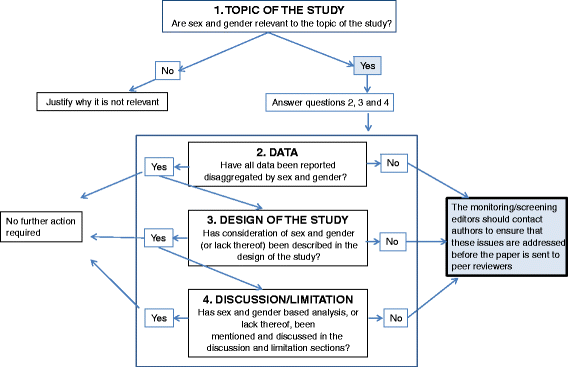Sex and Gender Equity in Research: rationale for the SAGER guidelines and recommended use
- PMID: 29451543
- PMCID: PMC5793986
- DOI: 10.1186/s41073-016-0007-6
Sex and Gender Equity in Research: rationale for the SAGER guidelines and recommended use
Erratum in
-
Publisher Correction: Sex and Gender Equity in Research: rationale for the SAGER guidelines and recommended use.Res Integr Peer Rev. 2024 Dec 20;9(1):15. doi: 10.1186/s41073-024-00155-7. Res Integr Peer Rev. 2024. PMID: 39707570 Free PMC article. No abstract available.
Abstract
Background: Sex and gender differences are often overlooked in research design, study implementation and scientific reporting, as well as in general science communication. This oversight limits the generalizability of research findings and their applicability to clinical practice, in particular for women but also for men. This article describes the rationale for an international set of guidelines to encourage a more systematic approach to the reporting of sex and gender in research across disciplines.
Methods: A panel of 13 experts representing nine countries developed the guidelines through a series of teleconferences, conference presentations and a 2-day workshop. An internet survey of 716 journal editors, scientists and other members of the international publishing community was conducted as well as a literature search on sex and gender policies in scientific publishing.
Results: The Sex and Gender Equity in Research (SAGER) guidelines are a comprehensive procedure for reporting of sex and gender information in study design, data analyses, results and interpretation of findings.
Conclusions: The SAGER guidelines are designed primarily to guide authors in preparing their manuscripts, but they are also useful for editors, as gatekeepers of science, to integrate assessment of sex and gender into all manuscripts as an integral part of the editorial process.
Keywords: Equity; Gender; Gender bias; Guidelines; SAGER; Scientific publishing; Scientific research; Sex.
Figures
Comment in
-
International Journal of Health Policy and Management (IJHPM): A Decade of Advancing Knowledge and Influencing Global Health Policy (2013-2023).Int J Health Policy Manag. 2023;12:8124. doi: 10.34172/ijhpm.2023.8124. Epub 2023 May 24. Int J Health Policy Manag. 2023. PMID: 37579384 Free PMC article. No abstract available.
References
-
- Coen S, Banister E, editors. What a difference sex and gender make: a gender, sex and health research casebook. Ottowa, Canada: Canadian Institutes of Health Research; 2012.
-
- Institute of Medicine (IOM) Sex-specific reporting of scientific research: a workshop summary. Washington, DC: The National Academies Press; 2012. - PubMed
Publication types
LinkOut - more resources
Full Text Sources
Other Literature Sources
Medical


